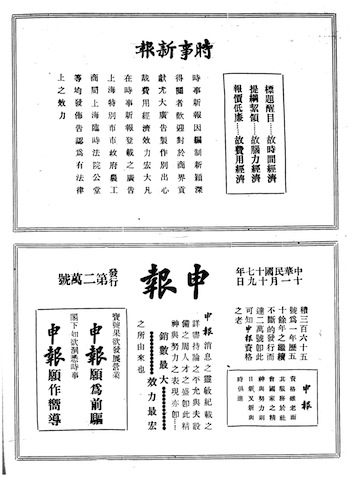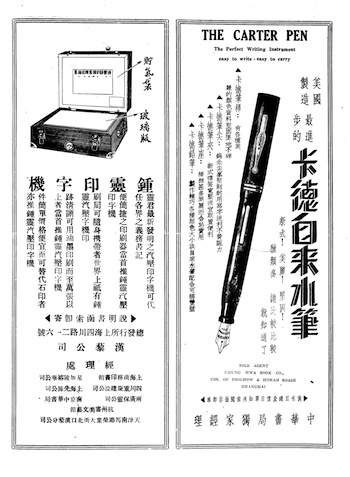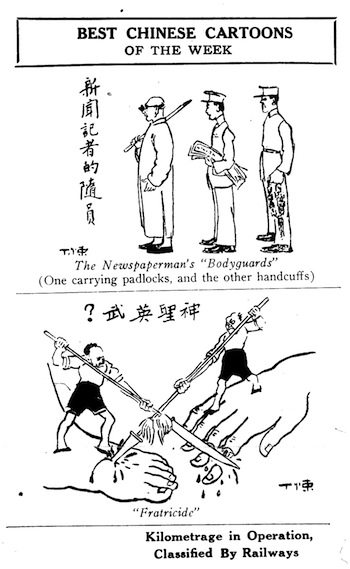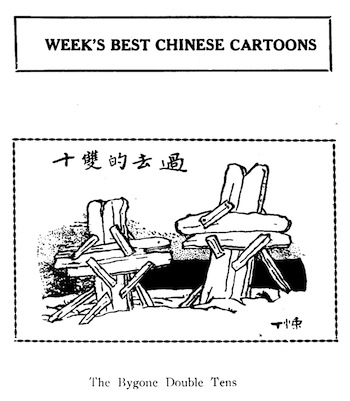FEATURES
The China Critic - 1930 | China Heritage Quarterly
The China Critic: a Chronology
William Sima
Australian Centre on China in the World
William Sima, whose research into the history and contents of The China Critic led to this combined issue of China Heritage Quarterly, has created a Chronology of the weekly. It follows the progress of The Critic from its first appearance in May 1928 through the highs and lows of the 'Nanjing Decade', and then through its various wartime permutations.
Will's Chronology, which is arranged by year below, accounts for the changing fate, and the friable editorial stance, of The Critic. It also provides numerous links to the articles under discussion allowing for them to be appreciated in an historical context.—The Editor
1928 | 1929 | 1930 | 1931 | 1932 | 1933 | 1934 | 1935 | 1936 | 1937 | 1938 | 1939 | 1940 | 1945
1930
27 February

Fig.1 Chinese-language advertisements for Shanghai Times 時事新報 and Shenbao 申報, 2 January
The Editorial 'On Mixed Marriage' ponders both the benefits and disadvantages of marriage between Chinese and foreigners—that is to say 'Westerners'. The writer describes the state of intermarriage in the following way:
We do not have the statistics to prove the statement, but it stands to reason that there are as many Frenchmen marrying British women as there are Britishers marrying French women, and as many German men marrying Italian women as there are Italian men marrying German women. But in China, the same rule does not apply, perhaps in ninety percent of the cases, Chinese men marry foreign women and in only ten percent of the cases, do we find Chinese women marrying foreign men.
Intending only to 'arouse some discussion on a point which have [has] been in the mind of many Chinese', this article speaks neither against nor in favour of mixed marriages.
6 March
Durham S.F. Chen's 陳石孚 article 'What Ails the Press of Shanghai' is an indictment ofthe quality of newspapers and reporting in the city. He questions the city's reputation as the 'civilizing' centre of reliable journalism in China:
We who are fortunate enough to be in daily contact with this 'civilizing' influence are so obsessed with by the wonderful accomplishments of our press, that we lose all mental balance and can not see things in their proper perspective. But in our sober moments, when we are less enthused over our own merits and see ourselves as others see us, our preeminent position as a city of journalists at once dwindles into insignificance. Thus viewed, Shanghai not only fails to live up to its reputation as the centre from which all news emanates, but its very claim to a seat in the journalists' fraternity may even be questioned.
Chen contends that the Shanghai press fails in what should be its two principle duties: 'the supply of accurate information'; and, 'the formation and guidance of public opinion'. He cites several recent examples of what he perceives to be erroneous or misinformed reporting. The following week, Lin Yutang published 'My Experience Reading A Chinese Daily' in response.

Fig.2 Chinese language advertisements for the Zhongling printing machine 鐘靈印字機, and Carter fountain pen, 6 March
10 April
'The birth control craze has taken China by storm and set at naught China's traditional conception of filial piety which has as its first and foremost requirement the sacred perpetuation of the ancestral line', writes Reginald Young 楊振宗 in 'Is Birth Control Necessary?'
Highly critical of birth control, Young argues against its protagonists—who contend that it will 'curb infanticide' and prevent the birth of social 'misfits'—by claiming that Sun Yat-sen 'lamented the failure of the Chinese to keep pace with the phenomenal racial increase that obtains in foreign countries.' Believing that the Chinese population needs to grow, Young advocates industrial development as a means to lift the quality of life in the country:
To solve China's racial problem or the problems of her livelihood through birth control may be likened to the effort of a man who refuses to work to increase his income but prefers to add to it by denying himself the necessities of life… . To life her people out of a rut, so to speak, China has to promote and develop her home industries which, once firmly established, will open the door of employment to her teeming millions the majority of whom are without dependable means of livelihood.
22 May
The Editorial 'The Birth Control League' reports on the inauguration of the League on 15 May, and introduces its planned activities. While not disagreeing outright with the public advocacy of birth control, the writer of the Editorial makes it clear such a policy must be pursued with caution:
To safeguard against misuse and abuse, some such principle governing the dissemination of contraceptive information is absolutely indispensable. The detail as to the application of this principle is yet to be worked out. We may anticipate wrongly, but we do hope that the principle will not mean the meting out of contraceptive knowledge only to selected classes of individuals or families, and the withholding of it from others… . In short, a rational and effective clinical service in birth control must go hand in hand with a sound system of eugenic education.
3 July
'The Little Critic', a weekly column edited by Lin Yutang, makes its first appearance in this issue. In the inaugural column Lin promises to eschew the self-righteous tone of the '“big” papers [which have] a monopoly of all the serious topics of human affairs', in favour of a lighter tenor that may, by virtue of its 'littleness', be more humane and appealing:
We do not mean to say that we are going to bark louder, but let us bark more humanely. After all a man can be quite a human being when he takes off his dog collar and his stiff shirt, and comes back home sprawling on the hearth-rug with a real relief. In our unbuttoned moods we shall speak.
This first 'Little Critic' essay featured two political cartoons from Chinese newspapers. Henceforth, 'Week's Best Chinese Cartoons' became a weekly feature, unfortunately only until November this year. Selected from contemporary Chinese periodicals, they often reflected the events discussed in the pages of The Critic.
17 July

Fig.3 'Best Chinese Cartoons' in The China Critic, 24 July; both are signed Ding Song 丁悚
T.K. Chuan's article 'The Terrible City' takes its title from a line in Jules Massenet's opera Thaïs, in which the protagonist Athanaël, a Christian monk, attempts to convert an Alexandrian courtesan (Thaïs) to Christianity only to find himself descending into lust for this woman, whose heart, in the end, is shown to be more pure that his own. 'Voila donc la terrible cité!', exclaims Athanaël as he approaches the gates of hedonistic Alexandria.
Chuan depicts the city language that recalls Western criticisms of the hedonistic metropolisthe appearance of which foretells the collapse of civilization. Both Alexandria and Shanghai are 'cosmopolitan' cities; both are 'commercial and industrial'; and both are centres of theatrical and artistic life. '[T]he comparison between the two cities however cannot be carried too far', Chuan admits: while Alexandria was a genuine centre of culture and learning, 'culturally Shanghai is nil.'
Indeed like another Athanael, we too wish to sing a hymn of hate and condemnation with however this difference: Athanael hated Alexandria for her science, her gentleness and her beauty; but we hate Shanghai for her ignorance, her unmanneredliness and her lack of beauty… . Civilizations rise and fail, Empires wax and wane, perhaps only in voluminous treaties written by learned doctors and paranoiac prophets, but this much we are such: Shanghai is a terrible city!
14 August
In 'The Little Critic' this week, Lin Yutang offers his own perspective on Shanghai hedonism: 'Mr. Chuan might have spared his historical learning in proving his these [thesis]: a glance ot [at] the stupid and vulgar faces gather at a Majestic tea-dance would convince anybody'. Lin presents his 'Hymn to the Great Terrible City'.
(Lin later included this in a collection of his 'Little Critic' essays under the title 'A Hymn to Shanghai', republished in China Heritage Quarterly, June 2010.)
16 October

Fig.4 The political cartoon 'The Bygone Double Tens' 過去的雙十, 16 October, presents a decidedly more sombre picture of the anniversary
The nineteenth anniversary of the Xihai Revolution 辛亥革命 this year coincides with the end to hostilities between the forces of Chiang Kai-shek and the notorious 'Northern Coalition' of the warlords Yan Xishan 閻錫山 and Feng Yuxiang 馮玉祥. The China Critic responds with a mixture of optimism and critical reflection.
The Editorial 'General Chiang on Post-War Problems' reports that: 'The war in the North has happily concluded with the anniversary celebration of the Republic on October 10th'. It goes on to enumerate a number of tasks confronting the Kuomintang, which Chiang himself outlined in an anniversary manifesto. These include: 'the complete eradication of communism and banditry'; 'lethargy and inefficiency'; and, systemic corruption within Kuomintang officialdom. Another essay, 'The Chinese Republic Enters her Twentieth Year', provides a year-by-year account of important events in first two decades of the Republic.
13 November
After receiving 'a communication from a group of friends regarding the need and the possibility of establishing a liberal cosmopolitan club in Shanghai', The China Critic responds with its endorsement in the Editorial titled 'Proposal for a Liberal Cosmopolitan Club in Shanghai':
In consonance with our policy of trying to establish and foster a tradition of liberal thought in China, the editors of The China Critic have always felt the desirability of having such a club established, a club of men who can think, or a willing to make an effort to think, over and above the merely nationalistic lines.
25 December
In 'Racial Mockery in Motion Pictures', Frederick Hung 洪紱 writes a critique of the recent motion picture Welcome Danger, starring Harold Lloyd. When screened in Shanghai, 'the Chinese public interfered with its projection on the screen and agitated until the government issued a nationwide bad on all of Lloyd's films.' Hung discusses different racist stereotypes in Hollywood generally, and the negative effects that they are likely to have on public culture. He arrives at the following conclusion:
A huge question, therefore, hangs over Hollywood: is it going to enlighten the world with the blessings of modern civilization and human progress? or, on the contrary, as some pictures are now doing, poison humanity with ideas of mutual hatred and suspicion? It is a question which ought to interest not only those people habitually misrepresented in American films, but also all those who desire better international understanding and cooperation.
1928 | 1929 | 1930 | 1931 | 1932 | 1933 | 1934 | 1935 | 1936 | 1937 | 1938 | 1939 | 1940 | 1945
|